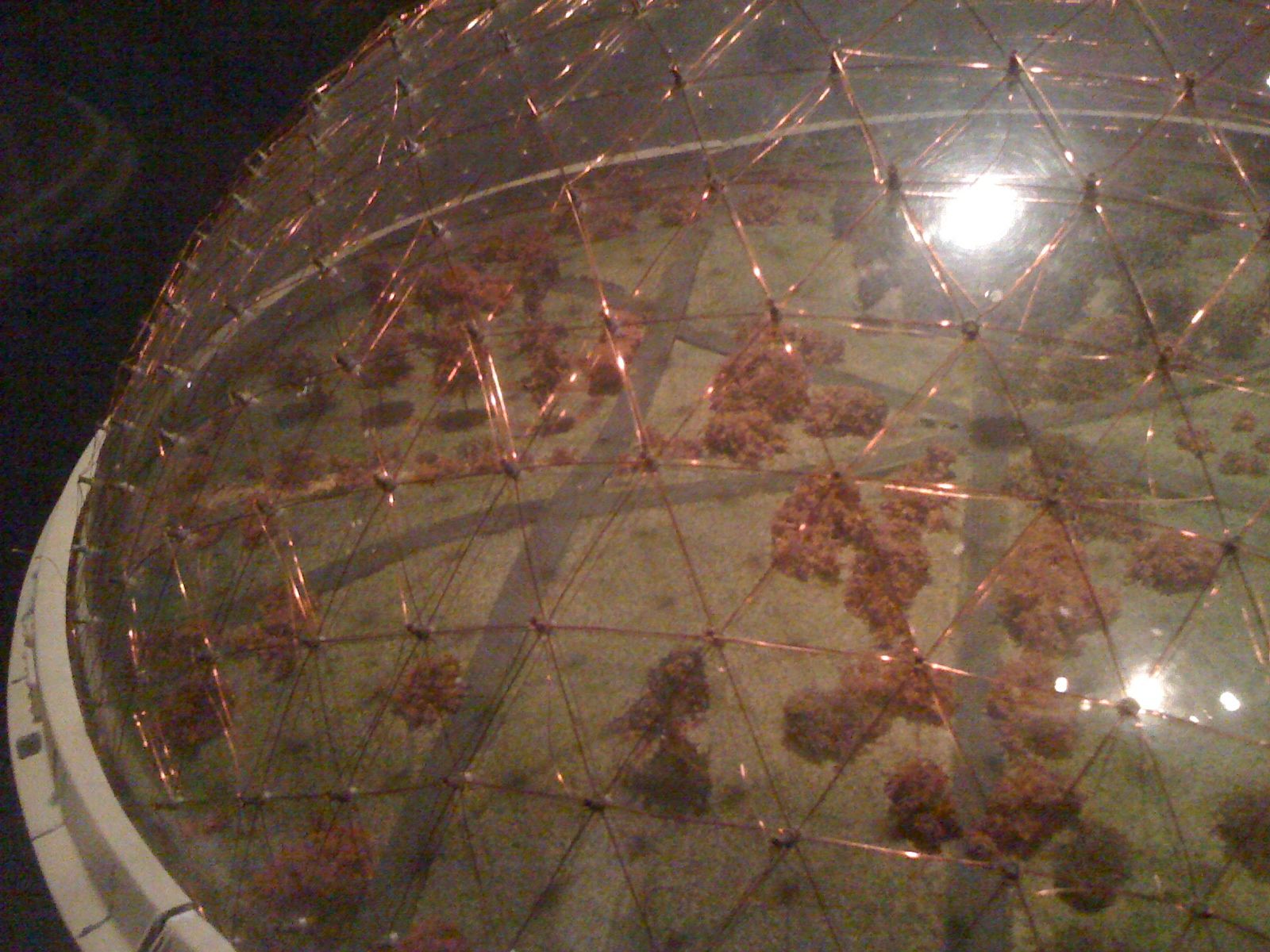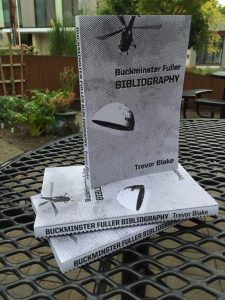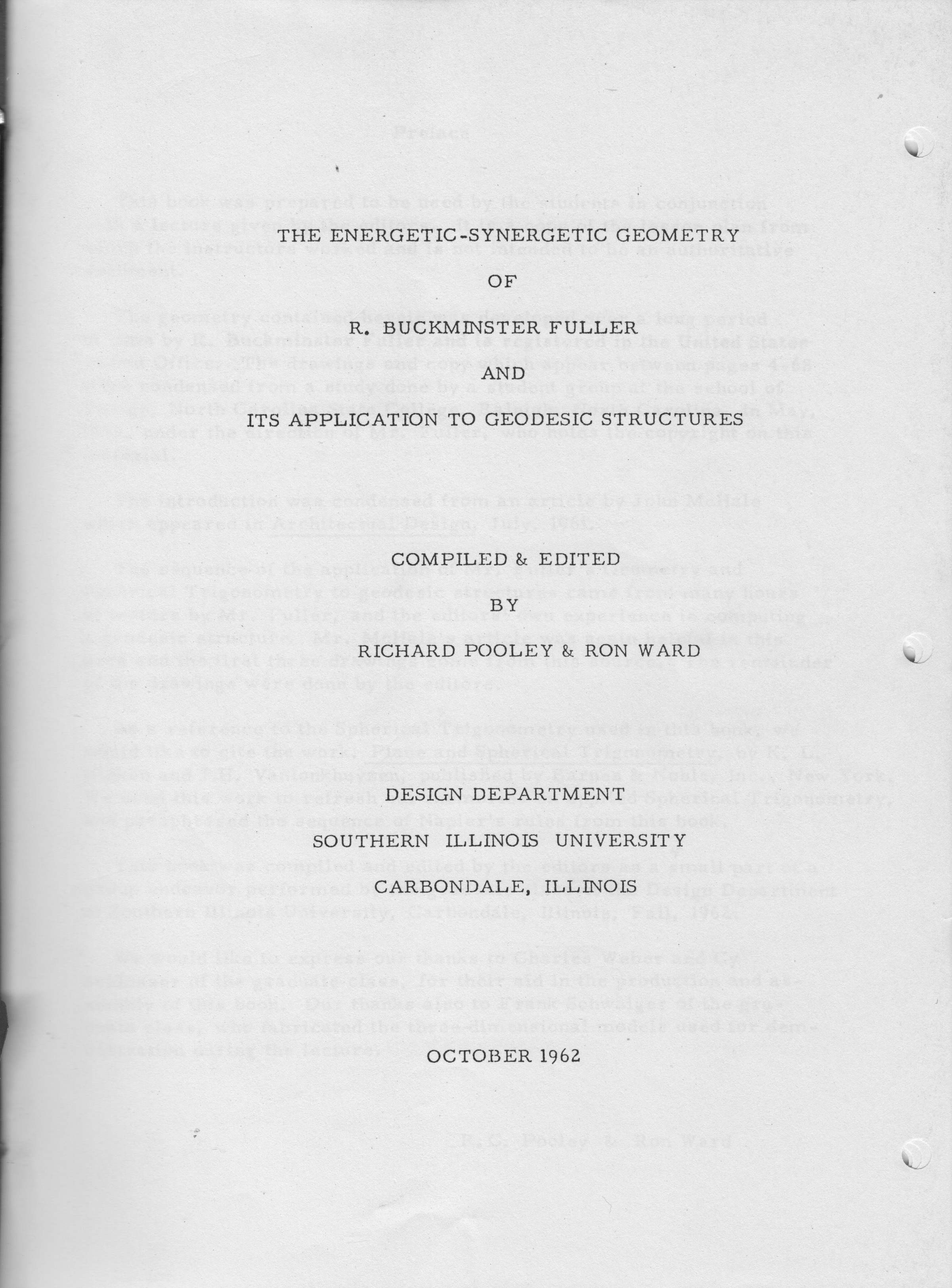Buckminster Fuller Bibliography
Buckminster Fuller Bibliography by Trevor Blake.
One thousand five hundred entries by and about Buckminster Fuller. Books, magazines, newspapers and ephemera published between 1914 and 2015.
Richard Buckminster “Bucky” Fuller (1895 – 1983) was a public speaker, author, mathematician and inventor. Fuller is best known as the popularizer of geodesic domes in architecture. He attempted to apply the most recent discoveries of science to the most basic of human needs such as shelter and transportation, without regard for precedent or profit or power, doing more with less. He called this process design science.
Paperback
260 pages
Introduction, Bibliography, Index
$17.50
ISBN 978-1944651022
“Lost Inventions” and “Bibliography” Going Out of Print January 2016
Addendum 2016: The complete contents of “The Lost Inventions of Buckminster Fuller” have now been published for free at synchronofile.com.
See BOOKS for more information on Buckminster Fuller Bibliography and other books.
Synergetics Stew July 2013
Ownership is going to go - not because it is politically unattractive, but because it is onerous. Man thought he had roots, not legs, and could keep many treasures. Now that we have refrigerators and cans, he doesn’t have to go where his roots are. He goes where his legs can take him. Museums existed when we had roots. Now we should take things out of museums and put them were they belong. Young people will be able to go around the world to see these things. Do you know they are rebuilding Babylon? - RBF interviewed by Lynn Sherr in Herald Advertiser, 25 October 1971.
The Buckminster Fuller Institute published the book Synergetic Stew: Explorations in Dymaxion Dining in 1982. Under this name, synchronofile.com publishes an irregular collection of brief notes relating to Buckminster Fuller.
☂ I continue to index the papers of the Buckminster Fuller Virtual Institute, donated by Joe Moore in 2013. My Fuller collection is now made up of tens of thousands of items and weights over five tons. These books, newspapers, magazines and other artifacts are available for study by appointment. As duplicates appear I am adding them to a lending library.
☂ Divided Spheres / Geodesics and the Orderly Subdivision of the Sphere by Edward S. Popko (CRC Press: Boca Radon 2012) does us the tremendous honor of including synchronofile.com among only a small number of links in the reference section of this important book.
☂ Sam Green and Yo La Tengo continue to tour their show titled The Love Song of R. Buckminster Fuller. Each performance is unique, including information about Fuller’s relation to the location of the performance.
☂ The 50-foot Fly’s Eye dome commissioned by RBF and constructed by John Warren has been restored. After decades of rough storage in a California cow pasture, it is now on exhibition at the Toulouse International Art Festival in France.
☂ A fascinating collection of links on the mathematics of bee hives, specifically the hexagonal honeycomb. This is of interest to those following RBF’s claim that nature is efficient.
☂ R. Buckminster Fuller: THE HISTORY (and Mystery) OF THE UNIVERSE by D. W. Jacobs is not yet available on DVD. But sections of the play have been documented and are online. From the 2008 performance, a trailer. From the 2010 performance, a rehearsal and a trailer.
☂ Sam Lanahan accompanied Buckminster Fuller on his speaking tour of Southeast Asia in 1976. Currently he is promoting a new invention called FlexBlox.
Trevor Blake is the author of the Buckminster Fuller Bibliography, available at synchronofile.com
Energetic-Synergetic Geometry 1962
R. Buckminster Fuller signed a book contract with Macmillan Publishing Company in 1961. The book in question, Synergetics, was not begun until 1969 and not published until 1975. The Energetic-Synegetic Geometry of R. Buckminster Fuller was published in a single, small-run edition in 1962 and has not seen print since. This is the first publication of the cover of this book, a small gift to the internet in honor of Fuller’s birthday. The twelfth of July was a special day for Fuller…
The Lost Inventions of Buckminster Fuller - Kindle Edition
Addendum 2016: The complete contents of “The Lost Inventions of Buckminster Fuller” have now been published for free at synchronofile.com.
See BOOKS for more information on Buckminster Fuller Bibliography and other books.
Buckminster Fuller Bibliography - Kindle Edition
Addendum 2016: See BOOKS for more information on Buckminster Fuller Bibliography and other books.
R. Buckminster Fuller’s Influence on Science Fiction Films and Television

R. Buckminster Fuller’s influence on science fiction films and television during his lifetime (12 July 1895 – 1 July 1983).
First Spaceship on Venus
[Wikipedia] [IMDB] [youtube]
1960. Film. Directed by Kurt Maetzig. Based on the novel The Astronauts by Stanisław Lem. An international rocket crew finds geodesic domes on the planet Venus.
Earth II
[IMDB]
1971. Television. Directed by Tom Gries. A space station makes a claim for independence from the Earth it orbits. R. Buckminster Fuller is credited as the “Technical Advisor for Earth” in Earth II. Fuller’s Dymaxion Map is used to track orbiting satellites in an Earth-bound control room.
Slaughterhouse 5
[Wikipedia] [IMDB] [youtube]
1972. Film. Directed by George Roy Hill. Based on the novel Slaughterhouse Five by Kurt Vonnegut Jr. Billy Pilgrim is kept in a geodesic dome in a zoo on the planet Tralfamadore.
Silent Running
[Wikipedia] [IMDB] [youtube]
1972. Film. Directed by Douglas Trumbull. The spaceship Valley Forge includes several geodesic domes.
The Starlost
[Wikipedia] [IMDB] [youtube] [The Starlost: The Word]
22 September 1973 – 5 January 1974. Television. Directed by Leo Orenstein. Created by Harlan Ellison. Executive Producer was Douglas Trumbull of Silent Running. A geodesic dome from the spaceship Valley Forge from Silent Running is re-used on the spaceship The Ark.
Battlestar Galactica
[Wikipedia] [IMDB] [Battlestar Wiki: Agro Ship]
September 17, 1978 – April 29, 1979. Television. Created by Glen A. Larson.
The geodesic dome from the spaceship Valley Forge from Silent Running which had been re-used on the spaceship The Ark in The Starlost is re-used once more on an Argo Ship. This dome is on exhibit at the EMP Science Fiction Museum between 23 October 2010 - 4 March 2012.
See also LOST Domes.
- Trevor Blake
Trevor Blake is the author of the Buckminster Fuller Bibliography, available at synchronofile.com
R. Buckminster Fuller: A Verb on Two Legs
In celebration of R. Buckminster Fuller and the 12 of July, the background images from my lecture “The Approximately Omnidirectional Ephemeralization of Richard Buckminster Fuller” as an 11 minute silent b/w video.
Also: for the month of July 2010 my two books on Fuller are deeply discounted. This is the month to buy them!
The Buckminster Fuller Bibliography - buy now for $35.00 $25.00 $1.99.
A Study of Shelter Logistics for Marine Corps Aviation - buy now for $25.00 [TEMPORARILY OUT OF PRINT]
- Trevor Blake
Trevor Blake is the author of the Buckminster Fuller Bibliography, available at synchronofile.com
Synergetics Stew January 2009
The Buckminster Fuller Institute published the book Synergetic Stew: Explorations in Dymaxion Dining in 1982. Under this name, synchronofile.com publishes an irregular collection of brief notes relating to Buckminster Fuller.
☂ BLDGBLOG writes about the myriahedral projection map of computer scientist Jack van Wijk (Eindhoven University of Technology in the Netherlands). “Making truly accurate maps of the world is difficult because it is mathematically impossible to flatten a sphere’s surface without distorting or cracking it. The new technique […] uses algorithms to ‘unfold’ and cut into the Earth’s surface in a way that minimizes distortion, and keeps the distracting effect of cutting into the map to a minimum.” Compare van Wijk’s work with Buckminster Fuller’s Dymaxion Map and with Butteryfly Map of Bernard Joseph Stanislaus Cahill.
☂ Speaking of Cahill, Gene Keyes has published a comparison of Cahill’s Butterfly Map and Fuller’s Dymaxion Map. Gene was a student of Fuller’s at Southern Illinois University in Carbondale, Illinois. Nearly 40 years ago Gene wrote Bucky and Pick: Two Grand Designers of a World Without War. An Essay-Review of Robert Pickus (To End War) and R. Buckminster Fuller (Utopia or Oblivion). Fuller sent a handwritten letter to Norman Cousins (editor of Saturday Review) urging Cousins publish the essay. The essay has never been published - until now.
☂ The Imaginary Foundation is selling an “All-Star Pattern Seeker Trading Cards pay tribute to 23 giants of pattern recognition - pathfinders and ideanauts whose shadows loom large across three millennia of discovery. This set of 23 cards comes in a collectible embossed box.” Buckminster Fuller is one of the all-star pattern seekers so honored.
☂ Playboy Magazine mentions Fuller in the profile of Susan Miller (Miss September 1972) and an interview with Allen Ginsberg but some other Fuller information hasn’t made it online yet. This includes the Playboy article “Cities of the Future” from January 1968 and an interview from February 1972. Buckminster Fuller: Anthology for a New Millennium edited by Thomas Zung incorrectly cites Fuller’s Playboy interview in the year 1970. Fuller makes some remarkable claims in his Playboy interview… “I’m not surprised to see women getting naked, because the more naked they are, the more they tend to discourage the sex urge. If a woman is covered up with skirts, man is driven by curiosity. Take away the skirts and he says to hell with it. And I find us getting an enormous amount of homosexuality, which I see as nature supplying us a negative urge that diminishes our capacity to make babies.” “Man probably came to this planet as whole man, a creature very much like what we see today. He might have been sent by electromagnetic waves.” “You could take human beings and inbreed them until you came up with a monkey. You can see that happening every day. Lots of people are halfway to monkey.” See also Buckminster Fuller, Creationist.
☂ Science Daily writes that Salvatore Torquato (Princeton Institute for the Science and Technology of Materials) and Yang Jiao (Department of Mechanical and Aerospace Engineering) have bested the world record set last year by Elizabeth Chen (University of Michigan) for tetrahedra packing. “Torquato and Jiao were able to fill a volume to 78.2 percent of capacity with tetrahedra.” Buckminster Fuller made no specific claims about the closest packing of tetrahedra but would likely have found this discovery of interest.
☂ synchronofile.com had the honor of announcing the restoration of the Dymaxion Car in September 2009. This resulted in a spike of interest in the car both on and off the Internet (see below). Crosthwaite and Gardiner, the company trusted with the restoration, have published some remarkable photographs of their work in progress here and here. Your help is still needed in identifying the source components used in the original Dymaxion Car.
☂ Noel Murphy is filming a documentary titled The Last Dymaxion. “One of the greatest minds of our time designed the very first green car. Certain corporations destroyed the possibility of that car ever being produced, but now, in the 21st century, the last Dymaxion is being restored, and along with it Buckminster Fuller’s Dream.” Noel is also the author/lead in the play Buckminster Fuller Live. The Last Dymaxion is scheduled for release Christmas 2010.
☂ The 1929 automobile of Engelbert Zaschka exhibited features that were important to Fuller. It was a three-wheeled car, like his Dymaxion. But it could also easily be folded, disassembled and re-assembled as could Fuller’s Dymaxion House and many geodesic domes. Zaschka was an advocate and pioneer inventor for the personal helicopter, achieving Fuller’s goal of a personal omnidirectional transportation vehicle. More information at Wikipedia (English, German) German-language excerpt from a television documentary on Zaschka here and a short film of the Zaschka being disassembled here.
☂ Hillary Louise Johnson wrote Super Vixens’ Dymaxion Lounge in 1997. Chapters one through six of Super Vixens’ Dymaxion Lounge are now online. Salon described the book as “a slim but wickedly brutal take on existential life in modern L.A., and one woman’s quest for depth amidst the neon-drenched chaos and urban (not to mention urbane) sprawl. With a toddler in tow all the while. […] Much of the book focuses on Johnson’s search for a way past such hackneyed responses, but she’s also aware of how difficult that is in a town where, a friend tells her, ‘style is substance.’ L.A. is a ‘dymaxion’ town, a term used by Buckminster Fuller to describe a world unto itself, where everything intermeshes and everything is available. So she’s wise enough to know that the idea of breaking through clichés is a cliché itself. Is she really going to be gratified by seducing the Little Caesar’s delivery boy, dating a couple, hanging out with drag queens? Nothing’s ironic in a town built on irony; a teacher at a Montessori school placidly tells Johnson that ‘the playground’s in the backyard, very safe from drive-by shootings.'”
☂ D. W. Jacob’s play R. BUCKMINSTER FULLER: THE HISTORY (and mystery) OF THE UNIVERSE will be performed May 28 - July 4, 2010 at the Arena Stage Crystal City in Washington, DC. Doug tells me: “Crystal City has put out an international call for artists to create outdoor works of art around Bucky themes and concepts, etc.” More information available from the Arena Stage.
☂ Kirby Urner was the first webmaster for the Buckminster Fuller Institute (bfi.org circa 1996 via archive.org). His sites 4D Solutions and grunch.net were some of the first and best online for Fuller mathematics. He was a consultant for textbook publisher McGraw Hill and continues to serve as an educator. Kirby is involved in the Thunderbird Early College Charter School, IEEE, Leadership & Entrepreneurial Public Charter High School, python and linux development and much more. Sometimes Kirby openly promotes Fuller in his educational work, sometimes he works in stealth mode. See a little of both in action at the Oregon Curriculum Network. Kirby’s style is that of a river: as deep as it flows, it also flows swift. He’s on to the next problem before you dry off from the first. Try to catch up with Kirby via Grain of Sand, Control Room , Coffee Shops Network, and the BizMo Diaries. Each of these is generously illustrated with his flickr photo stream.
- Trevor Blake
Trevor Blake is the author of the Buckminster Fuller Bibliography, available at synchronofile.com
4D Syndicate, The First Google Wave for Buckminster Fuller
R. Buckminster Fuller, Education Automation (1961):
I am quite certain that we are soon going to begin to do the following: At our universities we will take the men who are the faculty leaders in research or in teaching. We are not going to ask them to give the same lectures over and over each year from their curriculum cards, finding themselves confronted with another roomful of people and asking themselves, “What was it I said last year?” This is a routine which deadens the faculty member. We are going to select, instead, the people who are authorities on various subjects - the men who are most respected by other men within their respective departments and fields. They will give their basic lecture course just once to a group of human beings, including both the experts in their own subject and bright children and adults without special training in their field. This lecture will be recorded as Southern Illinois University did my last lecture series of fifty-two hours in October 1960. They will make moving picutre footage of the lecture as well as hi-fi tape recording. Then the professor and his faculty associate will listen to this recording time and again. “What you say is very good,” his associates may comment, “but we have heard you say it a little better at other times.” The professor then clubs in a better statement. Thus begins complete reworking of the tape, cleaned up, and cleaned up some more, as in the moving picture cutting, and new illustrative “footage” will be added on. The whole of a university department will work on improving the message and conceptioning of a picture for many months, sometimes for years. The graduate students who want to be present in the university and who also qualify to be with the men who have great powers and intellectual capability together with the faculty may spend a year getting a documentary ready. They will not depend upon diction of the original lecturer because the diction of that person may be inadequate his really fundamental conceptioning and information, which should be superb. His knowledge may be very great, but he may be a poor lecturer because of poor speaking habits or false teeth. Another voice will take over the task of getting his words across. Others will gradually process the tape and moving picture footage, using communications specialists, psychologists, etc. […]
The documentaries will be distributed by various means. One of the ways by which I am sure they will be distributed eventually has very much to do with an important evolution in communications history which will take a little describing. […] With two-way TV we will develop selecting dials for the children which will not be primarily an alphabetical but a visual species and chronological category selecting device with secondary alphabetical subdivisions. The child will be able to call up any kind of information he wants about any subject and get his latest authoritative TV documentary, the production of which I have already described to you.
You are invited to use your two-way TV to dial-in your superb fundamental conceptioning and information. Join 4D Syndicate, the first Google Wave for Buckminster Fuller. Real-time communication occurs at various times on the second day of each month. Synchronofile has a limited number of invitations to Google Wave available for the first few who request them.
[Update March 2011: Google has discontinued Google Wave.]
- Trevor Blake
Trevor Blake is the author of the Buckminster Fuller Bibliography, available at synchronofile.com

